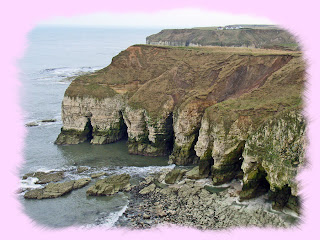 Head, the cliff scenery is spectacular and I walked from the lighthouse at the Head, some 5 miles north to Bempton Cliffs, constantly impressed by the ruggedness and height of the tortured limestone cliffs, with countless coves, caves, arches and an abundance of birdlife. But, of course, what had really prompted the trip was a search for the Northumbrian Coble.
Head, the cliff scenery is spectacular and I walked from the lighthouse at the Head, some 5 miles north to Bempton Cliffs, constantly impressed by the ruggedness and height of the tortured limestone cliffs, with countless coves, caves, arches and an abundance of birdlife. But, of course, what had really prompted the trip was a search for the Northumbrian Coble. To be honest, I didn't expect to find any - but there they were - an assortment of heavily constructed working boats, many still being used for crab and lobster fishing, as well as one or two also offering tourist trips. At this time of year, most were hauled out of the water and were being maintained in readiness for a new season. Many dated back to the 1930s, typically
 made of 22mm larch on oak ribs and keel, and were fitted with massive twin skegs complete with hauling rings for winding the vessels stern first out of the water. As can be seen, most sat on a simple pair of wheels. The reverse curvature of the keels was clearly visible although some had levelled this out with additional timber on the keel. I was told that curvature resulted in 'slack water' beneath the centre of the boat but opinion was divided as to the function this might serve. The most plausible view was that it evolved to cope with the need to launch from steep beaches into waves. Anyone who's tried this knows how readily the typical boat gets spun by the action of the waves to end up side on to the sea and heading for shore again - done it! - got the T-shirt - embarrassing! Possibly, with a deep forefoot and even deeper skegs set well to the stern, this twisting action is less likely; I'm not sure - someone out there will know.
made of 22mm larch on oak ribs and keel, and were fitted with massive twin skegs complete with hauling rings for winding the vessels stern first out of the water. As can be seen, most sat on a simple pair of wheels. The reverse curvature of the keels was clearly visible although some had levelled this out with additional timber on the keel. I was told that curvature resulted in 'slack water' beneath the centre of the boat but opinion was divided as to the function this might serve. The most plausible view was that it evolved to cope with the need to launch from steep beaches into waves. Anyone who's tried this knows how readily the typical boat gets spun by the action of the waves to end up side on to the sea and heading for shore again - done it! - got the T-shirt - embarrassing! Possibly, with a deep forefoot and even deeper skegs set well to the stern, this twisting action is less likely; I'm not sure - someone out there will know. Not surprisingly, none were sailing vessels, having been
 converted mostly with inboard engines but the smaller ones with outboards set into wells (the transom being typically too high and raked to easily accommodate an outboard). This required substantial alteration to the hulls, resulting in 'tunnels' - often clinker former - centrally located between the two skegs.
converted mostly with inboard engines but the smaller ones with outboards set into wells (the transom being typically too high and raked to easily accommodate an outboard). This required substantial alteration to the hulls, resulting in 'tunnels' - often clinker former - centrally located between the two skegs. 
As can be seen, the inboard props. were often position well forward. This has led me to wonder whether to position my outboard well or tunnel centrally rather than offset as per plans - might be
 more pleasing visually without loss of structural integrity . . . . may phone Paul of S.F. about it. Nearly all boats had an extra plank roved above the gunnels at the bow.
more pleasing visually without loss of structural integrity . . . . may phone Paul of S.F. about it. Nearly all boats had an extra plank roved above the gunnels at the bow.Did any of these boats ever have centre boards? - with heavy, deep skegs serving as bilge keels, probably not, especially since a centre board case wouldn't be popular on a working boat. Must check on this . . . .
Interestingly, coble design seems to have varied from one site to another on this coast. Often I would ask about a particular detail, only to be told that I must be thinking of cobles from a few miles up or down the coast . . . . 'we don't do them like that here . . . . However, tradition clearly isn't everything as repairs made generous use of Sikaflex.
In all, a lot of food for thought and a considerable admiration for the men who still work and maintain the distinctive vessels - I'd like to return to see one launched and recovered.







No comments:
Post a Comment